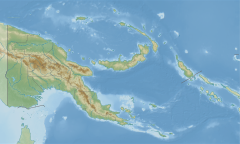The Tonda Wildlife Management Area is a wetland of international importance[3] and the largest protected area in Papua New Guinea.[4] It is located in the south-western corner of the Western Province and is contiguous with Wasur National Park of Indonesia. It forms part of the Trans Fly savanna and grasslands ecoregion.
| Tonda Wildlife Management Area | |
|---|---|
 Aerial view of the area near Bensbach airfield | |
Location in New Guinea | |
| Location | Western Province, Papua New Guinea |
| Nearest city | Merauke |
| Coordinates | 9°00′05″S 141°32′40″E / 9.00139°S 141.54444°E[1] |
| Area | 5,900 km2 (2,300 sq mi) |
| Established | 1975 |
| Designated | 16 March 1993 |
| Reference no. | 591[2] |
Vegetation and fauna
editThe terrain is flat, generally less than 45 metres above sea level. It includes tidal river reaches, mangrove areas, swamps, grassland, savanna woodlands and patches of monsoon forest. Most trees are of the genus Acacia and Melaleuca while common grasses are Phragmite and Pseudoraphis.
It is an important wetland for over 250 species of resident and migratory waterbirds. Most of the World's population of little curlew stage on the plains during migration. The area also provides habitat for birds-of-paradise[3] and brolga.[5]
Fifty-six species of fish have been recorded.[6] Fifty mammals are known to occur in the area, including a number not found elsewhere in New Guinea, such as the spectacled hare-wallaby, false water-rat, bronze quoll and chestnut dunnart. Reptiles include saltwater crocodile and New Guinea crocodile.[3]
Traditional landowners
editThe land is under customary ownership. About 1,500 subsistence gardeners and hunters live in the area in 12 villages.[3] The western part of Tonda covers land of the Kanum peoples.[7]
Conservation
editTonda Wildlife Management Area (WMA) was established in 1975. The WMA Rules restrict hunting by non-customary land owners.[8] In 1993 it was listed as a wetland of international importance under the Ramsar Convention.[3] In 1995 a Tri-National Wetlands Program was initiated by WWF between Tonda WMA, Wasur NP, and the Australian Kakadu National Park, which led to a Memorandum of Understanding between the three government conservation agencies in 2002.[9] In 2006 it was proposed as a World Heritage Site, as part of the larger Trans-Fly Complex.[4]
Cross-border issues
editThe WMA is the subject of poaching by people from neighbouring Papua Province, Indonesia. Local people also harvest and sell a number of wildlife resources to merchants on the other side of the border, including deer meat and antlers, candlenut, the plastra of freshwater turtles, shark fins, saratoga (Scleropages jardinii) fingerlings and the dried swim bladders of certain fish.[10]
See also
editReferences
edit- ^ "Tonda Wildlife Management Area". MPA Global. Retrieved 9 December 2012.
- ^ "Tonda Wildlife Management Area". Ramsar Sites Information Service. Retrieved 25 April 2018.
- ^ a b c d e Ramsar report for Tonda Wildlife Management Area, retrieved 15 May 2010
- ^ a b UNESCO: Trans-Fly Complex, retrieved 15 May 2010
- ^ Brolga, USGS. Archived 3 March 2013 at the Wayback Machine
- ^ Hitchcock, G. 2002 "Fish fauna of the Bensbach River, southwest Papua New Guinea" Memoirs of the Queensland Museum 48 (1): 119-122
- ^ Michele Bowe: One landscape, two lands: what the international border means for community-based natural resource conservation in southern New Guinea in The New Guinea Tropical Ecology and Biodiversity Digest, Issue 12, 2002, retrieved 16 May 2001
- ^ PacLII: Papua New Guinea Consolidated Legislation - Fauna (Protection and Control) Tonda Wildlife Management Area Rules 1976, retrieved 16 May 2010
- ^ Bowe, Michele: Community-Based Conservation in the Trans-Fly Region, in Marshall A.J.: The Ecology of Papua, Periplus, Singapore, 2007, ISBN 0-7946-0483-8
- ^ Hitchcock, G. 2004. Wildlife is Our Gold: Political Ecology of the Torassi River Borderland, Southwest Papua New Guinea. PhD Thesis, The University of Queensland
